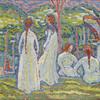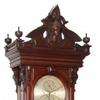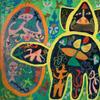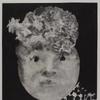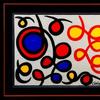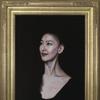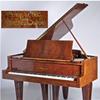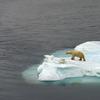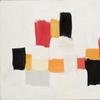Hot Art in a Cold War: Intersections of Art and Science in the Soviet Era
- GREENWICH, Connecticut
- /
- January 14, 2018
Opening on January 27, 2018, the Bruce Museum’s provocative new exhibition Hot Art in a Cold War: Intersections of Art and Science in the Soviet Era examines one of the dominant concerns of Soviet unofficial artists—and citizens everywhere—during the Cold War: the consequences of innovation in science, technology, mathematics, communications, and design. Juxtaposing art made in opposition to state-sanctioned Socialist Realism with artifacts from the Soviet nuclear and space programs, Hot Art in a Cold War touches upon the triumphs and tragedies unleashed as humankind gained the power to both leave the Earth and to destroy it.
Produced from the 1960s to the 1980s, the works on view address themes of international significance during a turbulent period marked by the ever-escalating competition for nuclear supremacy and the space race. Creative interpretations of these key historical events and their repercussions are presented here through nearly 40 works by 17 artists from the former Soviet republics of Estonia, Latvia, Ukraine, and Russia.
The Hot Art in a Cold War exhibition, which continues through May 20, explores the anxious realities and utopian fantasies of everyday Soviet life in the second half of the twentieth century through a variety of media, from documentary photographs and surrealist abstractions to hyperrealist paintings and kinetic sculptures. Kinetic artists in Russia and Latvia directly synthesized art and science in their works, often forming groups to collectively envision and even build immersive installations that offered viewers glimpses into unknown futures. As science became a proxy battlefield for the struggle between the USSR and the United States, the Soviet space program achieved a long string of successes, including launching the first artificial satellite, first animal, first human, and first space station into orbit. This exhibition features artifacts representing these breakthroughs, including an unlaunched backup of Sputnik, a replica of the spacesuit worn by the first space dog Laika, and equipment from the Salyut space station program. The darker side of this Cold War competition is seen in examples of nuclear fallout equipment and specimens from Chernobyl.
“The Bruce Museum prides itself in being a museum of both art and science and in finding the interconnections between the two,” says Dr. Daniel Ksepka, Bruce Museum Curator of Science and cocurator of the exhibition. “Hot Art in a Cold War is a perfect example of this unique focus. Visitors will see how the triumps of the space program and anxieties about nuclear arms were captured by period artists. Likewise, many of the scientific objects are works of art in their own right. The elegance of Sputnik, for example, is as striking and undeniable as its impact on the space race.”
“This exhibition is very timely, as we see history repeating itself in the connection between the ‘official’ behaviors of the Cold War and today’s ongoing wars and political conflicts, not to mention the everincreasing role that technology plays in our everyday lives,” adds Ksenia Nouril, exhibition co-curator. Hot Art in a Cold War is an expanded version of an exhibition organized at the Zimmerli Art Museum, Rutgers University, New Brunswick, N.J., by Ksenia Nouril, Dodge Fellow, Zimmerli Art Museum and PhD Candidate, Department of Art History at Rutgers.
“While the exhibition focuses on two main events of the Cold War—the nuclear arms and space races—museumgoers could place it within the context of a number of other related historical flash points, from the building of the Berlin Wall in 1961 to tearing it down in 1989, the Cuban Missile crisis in 1962, the Soviet-Afghan War (1979-1989), and the current crises in eastern Ukraine, Syria, and elsewhere,” Nouril explains.
A majority of the artworks on loan are from the Norton and Nancy Dodge Collection of Nonconformist Art from the Soviet Union, which is housed at the Zimmerli Art Museum. The late Norton Dodge (1927- 2011), an American economist, began collecting Soviet unofficial art during the Cold War, making several trips to the Soviet Union starting in 1955. He amassed one of the largest collections of this kind of art in the world.
Approximately 20,000 works from his collection were transferred to the Zimmelri in the 1990s. In this way, the Dodge Collection is very much a product of the Cold War, which pitted American capitalism against Soviet communism. Certain artworks in this exhibition, such as Aleksandr Zhitomirsky’s Ferocious Appetite (1969), focus on this fierce competition between these two nations. Other works, such as Valdis Celms’ Positron (1976) and Francisco Infante-Aranas’ Spirals, reveal the extent to which Soviet nonconformist artists were also inspired by the advancements in science that fueled military industrial complexes on both sides of the Atlantic. As unofficial artists who were not sanctioned by the state, they playfully and ironically depicted the positives and negatives of the effects of science, technology, and telecommunications in their works, such as Erik Bulatov’s The Soviet Cosmos (1977).
Although advancements in nuclear energy and space exploration gave great hope, they also came at a steep price, taking their toll on the Soviet economy, environment, and quality of life. Unofficial artists communicated their desires and fears by reimagining their earthly environments and conjuring unexplored worlds. Hot Art in a Cold War captures the direct and indirect intersections between art and science during this historically significant period of geopolitical tension that remains relevant today.




